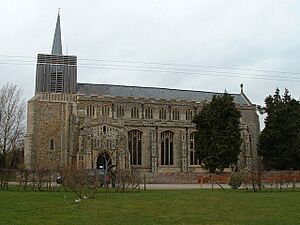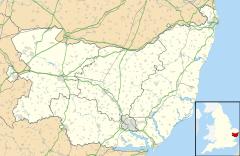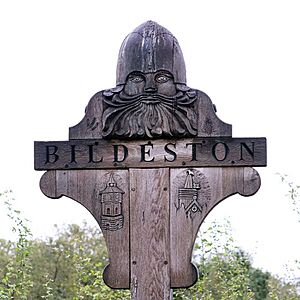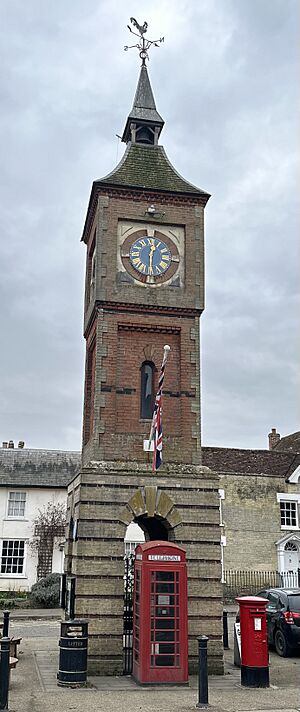Bildeston facts for kids
Quick facts for kids Bildeston |
|
|---|---|
 St Mary's Church, Bildeston |
|
| Area | 3.79 km2 (1.46 sq mi) |
| Population | 1,054 (2011) |
| • Density | 278/km2 (720/sq mi) |
| District |
|
| Shire county | |
| Region | |
| Country | England |
| Sovereign state | United Kingdom |
| Post town | IPSWICH |
| Postcode district | IP7 |
| EU Parliament | East of England |
Bildeston is a lovely village and civil parish in the Babergh area of Suffolk, England. It is located about 5 miles (8 km) north of Hadleigh. In 2011, the village had a population of 1,054 people.
Contents
Discovering Bildeston's Past
According to a language expert named Eilert Ekwall, the name Bildeston means "Bild's homestead." This suggests the village was once the home of someone named Bild.
A book called 'Bildeston Church and Village' by Sue Andrews says the village started around 1,100 years ago. Even though two Roman roads crossed here, there isn't much proof of a Roman settlement. People believe the first settlement was named after Bildr, a Danish leader who arrived seven centuries later.
Bildeston in the Domesday Book
The first clear record of Bildeston is in the Domesday Book. This was a big survey of England made in 1086. Before that, Bildeston was a royal estate belonging to Queen Edith, who was married to Edward the Confessor.
By 1086, Bildeston had 20 households. These included different types of workers like villeins, bordars, and serfs. They all worked for Walter the Deacon, who was the Lord of the Manor but didn't live there. The villagers had three plough teams, and the lord had three. There was also a priest with his own plough team, and his church was probably where St Mary Magdalene's Church is today.
Moving the Village
About 100 years later, Lady Helewise de Gwerres rebuilt the church. Her family, the Loveynes, later became the lords of the manor.
Some stories say the village moved down to the Brett valley because of the terrible Black Death in 1349. However, Matthew de Loveyne, the lord at the time, was given permission for a market in 1264. This was on the road between Stowmarket and Hadleigh. The move was likely slow and probably happened because it was easier to get water in the valley.
By 1603, when the Revett family took over the manor, only the manor house and the church were left on the hill. Maps from the early 1800s still showed houses on the road to the church.
Bildeston's Wool Trade
Bildeston became famous for its blue broadcloth, a type of wool fabric. Buildings for dyers, weavers, and cloth makers were built in the 1400s and 1500s. These buildings formed Chapel Street and Duke Street. A wool hall was also built where wool was bought and sold. It was similar to the one you can see in Lavenham. The Bildeston Hall still exists today but is now two private homes.
At first, this trade brought wealth. But changes in fashion and problems with trade meant that Bildeston started supplying yarn to Norwich instead of quality cloth to London. By 1674, many households were poor, and some had to go to the village workhouse.
Later Years
The weekly market stopped in 1764. A traveler named John Kirby described Bildeston as a "town in a bottom, meanly built and the streets are dirty." The manor house was torn down. The last fair in the village was held in 1872, with only one stall.
In the 1800s, more professional people moved to Bildeston. There were even plans for a railway station. The village, like many others in Suffolk, survived a long period of hardship and became successful again.
Bildeston Hall's Location
Bildeston Hall, where the lords of the manor sometimes lived, was southwest of the church. In 1974, farming uncovered parts of a circular moat and what might have been a fish pond. Pottery from the 11th to 17th centuries was also found. From the air, you can still see marks in the fields that show where the original Bildeston stood.
Bildeston's Clock Tower
In 1864, a clock tower was built in Bildeston. It became a Grade II listed building in 2010. This means it's an important historical building. The clock tower was built for the community and cost £200, paid for by selling a charity property and public donations.
Bildeston Village Signs
The village has two special signs that tell its story.
The Old Sign
The old sign was moved to a new spot outside the church. It's a wood carving that shows Bild(er)'s head at the top. Below it, you can see the clock tower on the left and the church tower on the right. This sign was first put up in 2005.
The New Sign
The new sign was revealed on July 9, 2022. It is located at the corner of High Street and Ipswich Road. This sign was given by TMJ Interiors and Heathpatch. The Village Sign People made the sign, and Dan Jarvis built and put up its base.
Themes on the New Sign
The new sign shows different parts of Bildeston's history and nature:
- Bilder: This represents a Danish Viking leader who arrived here in 878 AD.
- Church: Shows St Mary's church, which was built in the 14th century. The tower collapsed in the 1970s and was rebuilt. The church has beautiful stone carvings and a special window by the Kempe workshop.
- Countryside: Features a farming scene with an old tractor, showing the area's agricultural roots.
- Kings Pightle Nature Reserve: This part shows a kingfisher and mallard ducks on the river, representing the local nature reserve.
- Clocktower: The clock tower in the Market Place, built in 1864, is also featured.
- Weaver: This represents the important wool cloth industry that started in 1350.
Bildeston Today
Today, Bildeston is a busy village again. It has a post office, a general shop, and three pubs. Two of the pubs were turned into private homes about 40 years ago.
There are around 80 listed buildings in Bildeston. This means they are protected because of their historical importance.
The King's Head is a freehouse (a pub not owned by a brewery) that dates back to about 1530. It holds an annual beer festival at the end of May. The other pubs are The Crown, which is a gastropub (a pub that serves high-quality food), and The Red Lion. The Red Lion is a traditional pub with origins in the 1500s, though the current building is from the 1700s. It used to be in Wattisham until the parish boundary changed in 1882.
St Mary Magdalene Church
St Mary Magdalene Church stands a little way from the main village. On May 8, 1975, the church tower collapsed. The medieval bells had already been taken out for repairs. The new tower has a simple, functional top with a small spire.
The church's south porch has beautiful "flushwork," which are decorative patterns made with flint and stone. This shows the strong religious feelings of the 1400s. The doorway is considered one of the best of its time in the county. St Mary's also has a wonderful window by the Kempe workshop. It shows the Annunciation (when an angel told Mary she would have Jesus) and other scenes.
On January 23, 1958, the church was named a Grade I listed building. This is the highest ranking and means it's a building of exceptional interest.
Famous People from Bildeston
- Richard Wilson (1759–1834) was a Member of Parliament (MP) for Ipswich from 1806 to 1807.
- Frederic Growse (1836–1893) was born in Bildeston. He was a British civil servant in India, a Hindi scholar, an archaeologist, and a collector.
See also
 In Spanish: Bildeston para niños
In Spanish: Bildeston para niños





